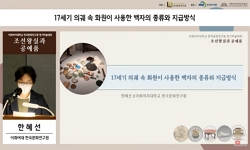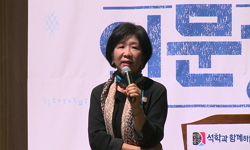The reign of King (later Emperor) Gojong of the Joseon dynasty (later the Korean Empire), which lasted from 1863 to 1907, was a period of turmoil caused by political and social instability at home and military incursions by foreign powers. It was also...
http://chineseinput.net/에서 pinyin(병음)방식으로 중국어를 변환할 수 있습니다.
변환된 중국어를 복사하여 사용하시면 됩니다.
- 中文 을 입력하시려면 zhongwen을 입력하시고 space를누르시면됩니다.
- 北京 을 입력하시려면 beijing을 입력하시고 space를 누르시면 됩니다.

고종 연간(1863~1907) 제작 어보(御寶) 연구 = A Study on the Production of Royal Seals during the Reign of King (Emperor) Gojong (r. 1863-1907)
한글로보기부가정보
다국어 초록 (Multilingual Abstract)
The reign of King (later Emperor) Gojong of the Joseon dynasty (later the Korean Empire), which lasted from
1863 to 1907, was a period of turmoil caused by political and social instability at home and military incursions by
foreign powers. It was also a period in which Joseon was proclaimed as the Korean Empire and, accordingly, the
royal seals of the dynasty underwent a major change.
Records show that some 135 seals were produced during the reign of Gojong. The present study of the makers
and styles of the royal seals aims to reveal a wealth of information on the seals, which typically had handles in the
shape of either a turtle or dragon.
Among the seal makers of this era, Jeon Heung-gil was particularly highly regarded as a Golden Royal Seal
Artisan (Geumbojang) because he was highly skilled at making both turtle and dragon handles. Kim Eun-seok,
a master Jade Royal Seal Artisan (Okbojang), also excelled in the production of turtle and dragon handles for his
jade seals. Another master Jade Royal Seal Artisan, Yi Jung-ryeo, is noteworthy because he developed a new style
of jade royal seals, which eventually became the dominant style after 1890, when Kim Eun-seok was not active.
Furthermore, after the 1890s, his style was also applied to the production of the gold royal seals and developed as
the dominant style.
Regarding the dragon handles adopted after the proclamation of the Korean Empire, both the golden and the
jade royal seals were made in the same style by the same artisans in the service of the Joseon dynasty. They adopted
the style of Chinese imperial seals when they began making seals with dragon handles for the Korean Empire,
although the basic shapes of both handle and dragon were copied from those made during the Joseon period.
As a ceremonial object symbolizing the authority and legitimacy of the royal or imperial family, the style of the
royal seals was influenced mainly by changes in the political situation at home and abroad. As Gojong’s reign was a
period in which more royal seals were made than in the reign of any other ruler, the seals originating from his reign
constitute a richer source of information about the efforts of the dynasty to preserve the tradition while effectively
dealing with the changes of the new era.
국문 초록 (Abstract)
고종이 집권했던 1863년부터 1907년은 불안한 국내 정세와 열강의 침입으로 혼란한 시기였지만, 조선 왕실과 대 한제국의 전환기로 왕(황)실의 어보(御寶) 제작에 있어 중요한 변화를 맞이하는...
고종이 집권했던 1863년부터 1907년은 불안한 국내 정세와 열강의 침입으로 혼란한 시기였지만, 조선 왕실과 대
한제국의 전환기로 왕(황)실의 어보(御寶) 제작에 있어 중요한 변화를 맞이하는 시기이기도 했다.
고종 연간 제작된 보인(寶印)은 대략 138과로 거북뉴(龜鈕)와 용뉴(龍鈕) 어보의 제작 장인, 조형을 분석하면 이
시기 보인 전반을 이해할 수 있다. 고종 연간 활동했던 대표적인 금보장(金寶匠) 전흥길(全興吉)은 왕실에서 다양한 금
속공예품을 제작하며 실력을 인정받아 활동했던 장인으로, 거북뉴 금보(金寶)와 용뉴 금보를 모두 제작할 수 있었던
뛰어난 장인이었다. 옥각수(玉刻手)·옥보장(玉寶匠)으로 활동한 김은석(金殷錫)도 전흥길과 마찬가지로 거북뉴 옥보
(玉寶)와 용뉴 옥보를 모두 제작할 수 있었던 장인이었다. 또한 옥보장 이중려(李仲呂)의 활동도 주목되는데, 김은석
이 활동하지 않는 동안 옥보의 새로운 양식을 창출했을 뿐 아니라 이 양식이 금보에도 적용되어 고종 연간 후반기인
1890년 이후 주요한 양식으로 자리하게 된다.
대한제국 수립 이후 제작된 용뉴의 경우 금보와 옥보가 유사한 양식을 공유하는데, 당시 『대례의궤(大禮儀軌)』에
기록된 장인들은 전흥길, 김은석 등 고종 연간 계속 활동해온 금보장, 옥보장이었다. 이들은 처음 용뉴의 어보를 제작
해야 할 때 문헌이나 기록 등으로 중국의 용뉴 인장 형식을 차용하였지만, 용뉴 형태와 용 모습은 당시 조선시대부터
제작되어온 용 조각을 모방한 것으로 보인다.
어보는 왕실과 황실의 정통성과 권위를 상징하는 의물로, 국내외 정세에 따른 변화를 가장 많이 반영하는 공예품
이다. 고종 연간은 역대 왕들의 재위 기간 중 어보가 가장 많이 만들어진 시기로 기존의 어보 제작 전통을 지키면서도
새로운 변화를 확인할 수 있다는 점에서 의미가 있다.
동일학술지(권/호) 다른 논문
-
- 국립문화재연구원
- 김지현
- 2021
- KCI등재
-
문화재 현상변경 인·허가 검토기준 마련을 위한 실태분석 연구- 최근 5년(2015~2019)간 국가지정문화재(사적)의 허가신청 안건 처리결과를 중심으로
- 국립문화재연구원
- 조홍석
- 2021
- KCI등재
-
- 국립문화재연구원
- 설지희
- 2021
- KCI등재
-
남녕위(南寧尉) 윤의선(尹宜善)의 1837년 「혼수발기」 속 부마 편복(便服) 고찰
- 국립문화재연구원
- 이은주
- 2021
- KCI등재




 RISS
RISS







